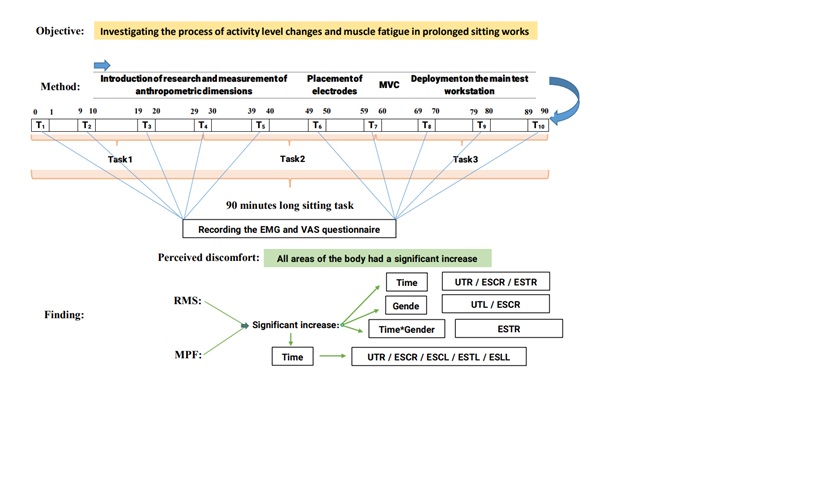Volume 13, Issue 2 (6-2023)
J Health Saf Work 2023, 13(2): 368-383 |
Back to browse issues page
Download citation:
BibTeX | RIS | EndNote | Medlars | ProCite | Reference Manager | RefWorks
Send citation to:



BibTeX | RIS | EndNote | Medlars | ProCite | Reference Manager | RefWorks
Send citation to:
Shaghaghi A, Kazemi Z, Sharifnead A, Garosi E, Mohammadalizadeh M, Mahdavi S H et al . Perceived Discomfort, Upper Body Muscular Activity, and Fatigue Over Unsupported Prolonged Sitting Tasks. J Health Saf Work 2023; 13 (2) :368-383
URL: http://jhsw.tums.ac.ir/article-1-6847-en.html
URL: http://jhsw.tums.ac.ir/article-1-6847-en.html
Alireza Shaghaghi1 
 , Zeinab Kazemi2
, Zeinab Kazemi2 
 , Ali Sharifnead3
, Ali Sharifnead3 
 , Ehsan Garosi1
, Ehsan Garosi1 
 , Maryam Mohammadalizadeh1
, Maryam Mohammadalizadeh1 
 , Seyed Hossein Mahdavi2
, Seyed Hossein Mahdavi2 
 , Mohammad Sadegh Ghasemi *
, Mohammad Sadegh Ghasemi * 
 4
4

 , Zeinab Kazemi2
, Zeinab Kazemi2 
 , Ali Sharifnead3
, Ali Sharifnead3 
 , Ehsan Garosi1
, Ehsan Garosi1 
 , Maryam Mohammadalizadeh1
, Maryam Mohammadalizadeh1 
 , Seyed Hossein Mahdavi2
, Seyed Hossein Mahdavi2 
 , Mohammad Sadegh Ghasemi *
, Mohammad Sadegh Ghasemi * 
 4
4
1- Department of Ergonomics, School of Public Health, Iran University of Medical Sciences, Tehran, Iran
2- Department of Industrial Engineering, Clemson University, Clemson, SC, USA
3- Department of Sport Biomechanics and Technology, Sport Sciences Research Institute, Tehran, Iran
4- Department of Ergonomics, School of Public Health, Iran University of Medical Sciences, Tehran, Iran ,ghasemi.m@iums.ac.ir
2- Department of Industrial Engineering, Clemson University, Clemson, SC, USA
3- Department of Sport Biomechanics and Technology, Sport Sciences Research Institute, Tehran, Iran
4- Department of Ergonomics, School of Public Health, Iran University of Medical Sciences, Tehran, Iran ,
Abstract: (1254 Views)
Introduction: In many occupations, users must sit for prolonged periods during their job activities. Prolonged sitting is associated with fatigue, leading to postural changes that can increase spinal loads. Despite the importance of this topic in terms of the extent of prolonged sitting and its subsequent adverse consequences, little attention has been given to this occupational activity. Hence, this study investigates changes in neck, trunk, and muscle activities and fatigue levels in prolonged sitting computer tasks.
Material and Methods: Twenty healthy subjects (gender-balanced) from the student community with at least five years of experience in computer work aged between 20-30 years were asked to randomly perform three types of computer tasks for 90 minutes (each task for 30 minutes). Electromyographic (EMG) activities of right and left cervical (ESCR and ESCL), thoracic (ESTR and ESTL), and lumbar (ESLR and ESLL) erector spine and upper trapezius (UTR and UTL) muscles were continuously recorded. Root mean square (RMS) and median frequency were extracted as EMG metrics. Subjects also rated their perceived discomfort using a Visual Analogue Scale (VAS). The effect of time, gender, and their interaction on muscle EMG activities, fatigue, and discomfort were explored.
Results: Time had a statistically significant effect on UTR, ESCR, and ESTR muscle activities. UTL and ESCR muscle activities significantly differed between male and female subjects. Further, the findings confirmed the interactive effect of time and gender on ESTR muscle activity. UTR, ESCR, ESCL, ESTL, and ESLL muscles’ fatigue index changed statistically over time.
Conclusion: The findings confirmed neck and trunk muscles’ fatigue by increasing muscular activity and reducing frequency contents over time, per the subjective rating of discomfort.
Material and Methods: Twenty healthy subjects (gender-balanced) from the student community with at least five years of experience in computer work aged between 20-30 years were asked to randomly perform three types of computer tasks for 90 minutes (each task for 30 minutes). Electromyographic (EMG) activities of right and left cervical (ESCR and ESCL), thoracic (ESTR and ESTL), and lumbar (ESLR and ESLL) erector spine and upper trapezius (UTR and UTL) muscles were continuously recorded. Root mean square (RMS) and median frequency were extracted as EMG metrics. Subjects also rated their perceived discomfort using a Visual Analogue Scale (VAS). The effect of time, gender, and their interaction on muscle EMG activities, fatigue, and discomfort were explored.
Results: Time had a statistically significant effect on UTR, ESCR, and ESTR muscle activities. UTL and ESCR muscle activities significantly differed between male and female subjects. Further, the findings confirmed the interactive effect of time and gender on ESTR muscle activity. UTR, ESCR, ESCL, ESTL, and ESLL muscles’ fatigue index changed statistically over time.
Conclusion: The findings confirmed neck and trunk muscles’ fatigue by increasing muscular activity and reducing frequency contents over time, per the subjective rating of discomfort.
Type of Study: Research |
Received: 2023/06/29 | Accepted: 2023/06/22 | Published: 2023/06/22
Received: 2023/06/29 | Accepted: 2023/06/22 | Published: 2023/06/22
Send email to the article author
| Rights and permissions | |
 |
This work is licensed under a Creative Commons Attribution-NonCommercial 4.0 International License. |





